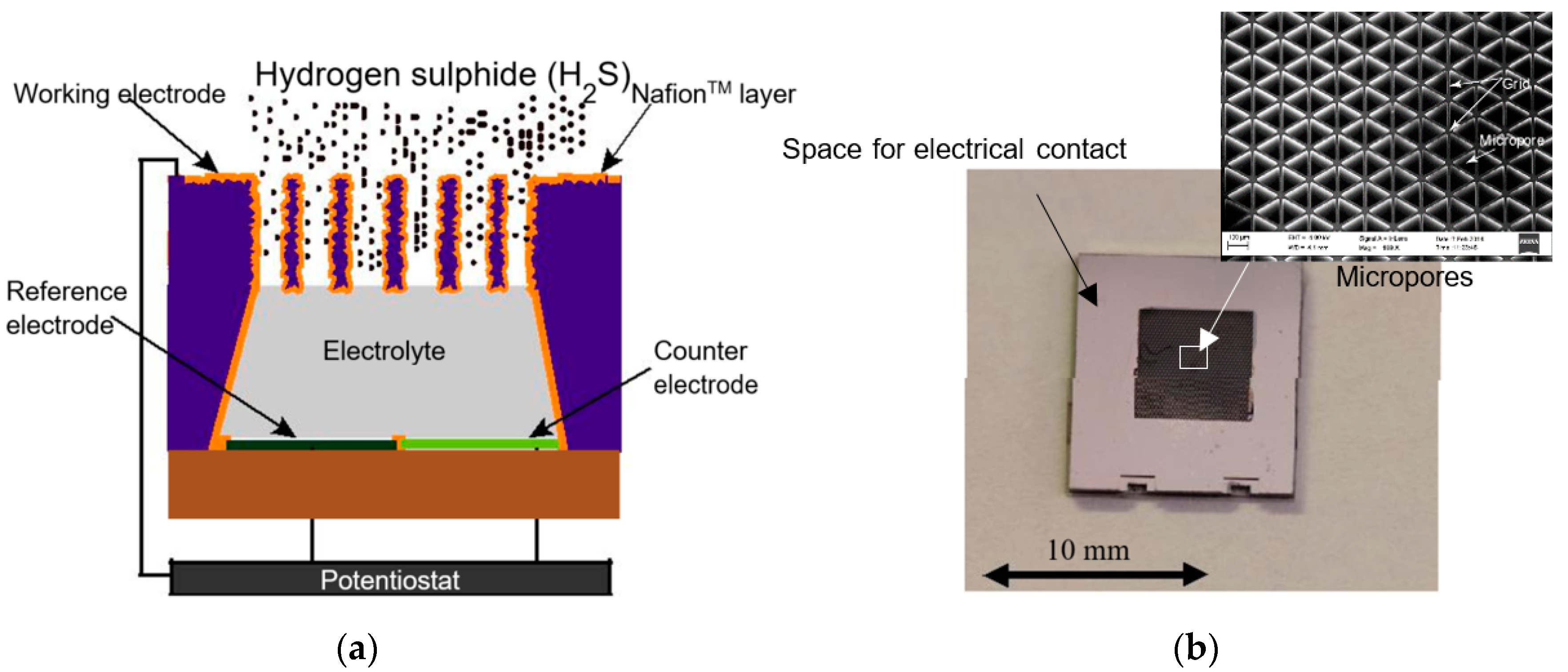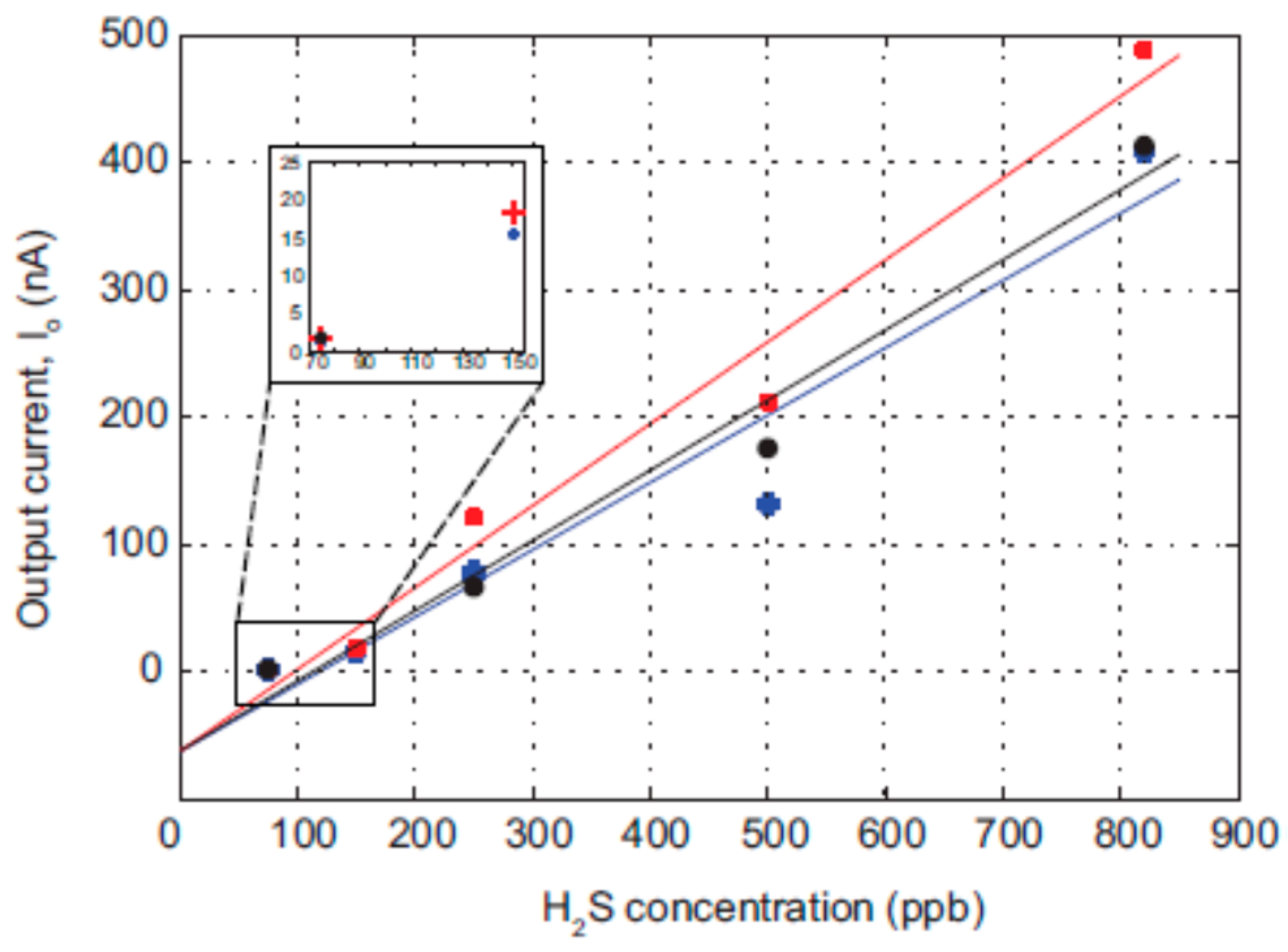A Miniaturized Amperometric Hydrogen Sulfide Sensor Applicable for Bad Breath Monitoring
Abstract
:1. Introduction
2. Sensor Design and Measurement Method
3. Results and Discussion
3.1. Sensitivity
3.2. Selectivity to NO and NH3
3.3. Response Time
3.4. Working Electrode Current Drift
3.5. Halitosis Measurement Range
4. Conclusions
Author Contributions
Funding
Acknowledgments
Conflicts of Interest
References
- Yokoyama, S.; Ohnuki, M.; Shinada, K.; Ueno, M.; Wright, C.; Allan, F. Oral malodor and related factors in Japanese senior high school students. J. Sch. Health 2010, 80, 346–352. [Google Scholar] [CrossRef] [PubMed]
- Apatzidou, A.D.; Bakirtzoglou, E.; Vouros, I.; Karagiannis, V.; Papa, A.; Konstantinidis, A. Association between oral malodour and periodontal disease-related parameters in the general population. Acta Odontol. Scand. 2013, 71, 189–195. [Google Scholar] [CrossRef] [PubMed]
- Van den Broek, M.; Feenstra, L.; de Baat, C. A review of the current literature on aetiology and measurement methods of halitosis. J. Dent. 2007, 35, 627–635. [Google Scholar] [CrossRef] [PubMed]
- Zürcher, M.; Laine, L.; Filippi, A. Diagnosis, prevalence, and treatment of halitosis. Curr. Oral Health Rep. 2014, 1, 279–285. [Google Scholar] [CrossRef]
- The Halimeter®—Measure Bad Breath Scientifically. 2015. Available online: http://www.halimeter.com/the-halimeter-measure-bad-breath-scientifically/ (accessed on 8 January 2015).
- Baharvand, M.; Maleki, Z.; Mohammadi, S.; Alavi, K.; Moghaddam, E. Assessment of oral malodor: A comparison of the organoleptic method with sulfide monitoring. J. Contemp. Dent. Pract. 2008, 9, 76–83. [Google Scholar] [PubMed]
- Donaldson, A.C.; Riggio, M.; Rolph, H.; Bagg, J.; Hodge, P. Clinical examination of subjects with halitosis. Oral Dis. 2007, 13, 63–70. [Google Scholar] [CrossRef] [PubMed]
- Chroma. Comparison between Oral Chroma and Halimeter. Available online: http://oralchroma.es/catalogos/OralChroma-vs-Halimeter-eng.pdf (accessed on 8 January 2015).
- Schiavon, G.; Zotti, G.; Toniolo, R.; Bontempelli, G. Electrochemical detection of trace hydrogen sulfide in gaseous samples by porous silver electrodes supported on ion-exchange membranes (solid polymer electrolytes). Anal. Chem. 1995, 67, 318–323. [Google Scholar] [CrossRef]
- Yang, X.; Zhang, Y.; Hao, X.; Song, Y.; Liang, X.; Liu, F.; Sun, P.; Gao, Y.; Yan, X.; Lu, G.; et al. Nafion-based amperometric H2S sensor using Pt-Rh/C sensing electrode. Sens. Actuators B Chem. 2018, 273, 635–641. [Google Scholar] [CrossRef]
- Horvath, I.; Loukides, S.; Wodehouse, T.; Csiszer, E.; Cole, P.; Kharitonov, S. Comparison of exhaled and nasal nitric oxide and exhaled carbon monoxide levels in bronchiectatic patients with and without primary ciliary dyskinesia. Thorax 2003, 58, 68–72. [Google Scholar] [CrossRef] [PubMed] [Green Version]
- Schmidt, F.M.; Vaittinen, O.; Metsälä, M.; Lehto, M.; Forsblom, C.; Groop, P. Ammonia in breath and emitted from skin. J. Breath Res. 2013, 7, 017109. [Google Scholar] [CrossRef] [PubMed] [Green Version]
- Gatty, H.K.; Stemme, G.; Roxhed, N. A wafer-level liquid cavity integrated amperometric gas sensor with ppb-level nitric oxide gas sensitivity. J. Micromech. Microeng. 2015, 25, 105013. [Google Scholar] [CrossRef]
- Gatty, H.K.; Leijonmarck, S.; Antelius, M.; Stemme, G.; Roxhed, N. An amperometric nitric oxide sensor with fast response and ppb-level concentration detection relevant to asthma monitoring. Sens. Actuators B Chem. 2015, 209, 639–644. [Google Scholar] [CrossRef]
- Tangerman, A.; Winkel, E. The portable gas chromatograph OralChroma™: A method of choice to detect oral and extra-oral halitosis. J. Breath Res. 2008, 2, 017010. [Google Scholar] [CrossRef] [PubMed]
- Furne, J.; Majerus, G.; Lenton, P.; Springfield, J.; Levitt, D.; Levitt, M. Comparison of volatile sulfur compound concentrations measured with a sulfide detector vs. gas chromatography. J. Dent. Res. 2002, 81, 140–143. [Google Scholar] [CrossRef] [PubMed]
- Interscan Corp., Simplified RH17K Manual. Available online: http://www.halimeter.com/images/Simplified_RH17K_Manual.PDF (accessed on 8 January 2015).







© 2018 by the authors. Licensee MDPI, Basel, Switzerland. This article is an open access article distributed under the terms and conditions of the Creative Commons Attribution (CC BY) license (http://creativecommons.org/licenses/by/4.0/).
Share and Cite
Gatty, H.K.; Stemme, G.; Roxhed, N. A Miniaturized Amperometric Hydrogen Sulfide Sensor Applicable for Bad Breath Monitoring. Micromachines 2018, 9, 612. https://doi.org/10.3390/mi9120612
Gatty HK, Stemme G, Roxhed N. A Miniaturized Amperometric Hydrogen Sulfide Sensor Applicable for Bad Breath Monitoring. Micromachines. 2018; 9(12):612. https://doi.org/10.3390/mi9120612
Chicago/Turabian StyleGatty, Hithesh K., Göran Stemme, and Niclas Roxhed. 2018. "A Miniaturized Amperometric Hydrogen Sulfide Sensor Applicable for Bad Breath Monitoring" Micromachines 9, no. 12: 612. https://doi.org/10.3390/mi9120612
APA StyleGatty, H. K., Stemme, G., & Roxhed, N. (2018). A Miniaturized Amperometric Hydrogen Sulfide Sensor Applicable for Bad Breath Monitoring. Micromachines, 9(12), 612. https://doi.org/10.3390/mi9120612




